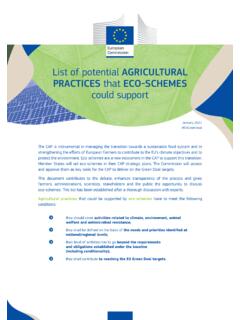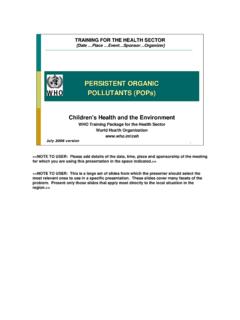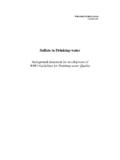Transcription of What is Organic Farming?
1 what isOrganic Farming? produced byHDRA - the Organic organisationOrganic FarmingWhat is Organic Farming? Organic farming works in harmony with nature rather than against it. This involvesusing techniques to achieve good crop yields without harming the naturalenvironment or the people who live and work in it. The methods and materialsthat Organic farmers use are summarised as follows:To keep and build good soil structure and fertility: recycled and composted crop wastes and animal manures the right soil cultivation at the right time crop rotation green manures and legumes mulching on the soil surfaceTo control pests, diseases and weeds: careful planning and crop choice the use of resistant crops good cultivation practice crop rotation encouraging useful predators that eat pests increasing genetic diversity using natural pesticidesOrganic farming also involves: careful use of water resources good animal husbandrypage 1 HDRA - the Organic organisationOrganic FarmingHDRA - the Organic organisationpage 2A modern approach to farmingOrganic farming does not mean going back to traditional methods.
2 Many of thefarming methods used in the past are still useful today. Organic farming takesthe best of these and combines them with modern scientific farmers do not leave their farms to be taken over by nature; they use allthe knowledge, techniques and materials available to work with nature. In thisway the farmer creates a healthy balance between nature and farming , wherecrops and animals can grow and be a successful Organic farmer, the farmer must not see every insect as apest, every plant out of place as a weed and the solution to every problem in anartificial chemical spray. The aim is not to eradicate all pests and weeds, but tokeep them down to an acceptable level and make the most of the benefits thatthey may techniquesOn an Organic farm, each technique would not normally be used on its farmer would use a range of Organic methods at the same time to allowthem to work together for the maximum benefit. For example the use of greenmanures and careful cultivation, together provide better control of weeds than ifthe techniques were used on their Farmingpage 3 HDRA - the Organic organisationWhy farm organically?
3 Organic farming provides long-term benefits to people and the farming aims to: increase long-term soil fertility. control pests and diseases without harming the environment. ensure that water stays clean and safe. use resources which the farmer already has, so the farmer needs lessmoney to buy farm inputs. produce nutritious food, feed for animals and high quality crops to sell at agood , intensive agriculture causes many problems, including the following: Artificial fertilisers and herbicides are easily washed from the soil andpollute rivers, lakes and water courses. The prolonged use of artificial fertilisers results in soils with a low organicmatter content which is easily eroded by wind and rain. Dependency on fertilisers. Greater amounts are needed every year toproduce the same yields of crops. Artificial pesticides can stay in the soil for a long time and enter the foodchain where they build up in the bodies of animals and humans, causinghealth problems.
4 Artificial chemicals destroy soil micro-organisms resulting in poor soilstructure and aeration and decreasing nutrient availability. Pests and diseases become more difficult to control as they becomeresistant to artificial pesticides . The numbers of natural enemies decreasebecause of pesticide use and habitat FarmingHDRA - the Organic organisationpage 4 Crop nutritionTo produce a healthy crop an Organic farmer needs to manage the soil involves considering soil life, soil nutrients and soil fertilisers provide only short term nutrient supply to crops. Theyencourage plants to grow quickly but with soft growth which is less able towithstand drought, pests and disease. Artificial fertilisers do not feed soil lifeand do not add Organic matter to the soil. This means that they do not help tobuild good soil structure, improve the soils water holding capacity or soil is a living system. As well as the particles that make up the soil, itcontains millions of different creatures.
5 These creatures are very important forrecycling the soil with manure or compost feeds the whole variety of life in thesoil which then turns this material into food for plant growth. This also addsnutrients and Organic matter to the soil. Green manures also provide nutrientsand Organic matter. These are plants with high nitrogen content that are sownas part of a rotation and are dug into the soil when is important to remember, however, that using too much animal manure ornutrient rich Organic matter, or using it at the wrong time, could be as harmfulas using man-made, artificial Organic farmer must cultivate the soil at the right time and in the right waysto provide the best living conditions for the soil life and plant Farmingpage 5 HDRA - the Organic organisationChoice of cropsEach crop and crop variety has its own specific needs. In some places it willgrow well and others it will not. Crops are affected by; soil type rainfall altitude temperature the type and amount of nutrients required the amount of water neededThese factors affect how a crop grows and yields.
6 If a crop is grown in aclimate to which it is not suited, it is likely to produce low yields and be moresusceptible to pest and diseases. This then creates the need to use agrochemicalsto fertilise the crop and control pest and successful Organic farmer learns to grow the crops and varieties which aresuited to the local conditions. He should grow crops which are suited to hisgeography and climate. He should choose varieties which are suited to the localconditions such as local FarmingHDRA - the Organic organisationpage 6 RotationsGrowing the same crops in the same site year after year reduces soil fertilityand can encourage a build up of pests, diseases and weeds in the soil. Cropsshould be moved to a different area of land each year, and not returned to theoriginal site for several years. For vegetables a 3 to 4 year rotation is usuallyrecommended as a rotation means having times where the fertility of the soil is being built upand times where crops are grown which remove rotation also helps a variety of natural predators to survive on the farm byproviding diverse habitats and sources of food for typical 4 year rotation would include a cycle with maize and beans, a rootcrop and cereals with either of the following;1.
7 Grass or bush fallow (a fallow period where no crops are grown).2. A legume crop where a green manure, which is a plant grown mainly forthe benefit of the soil, is grown (more information about green manures canbe obtained from HDRA).A simple rotation that includes a legumecereallegumerootsmaize /beansOrganic Farmingpage 7 HDRA - the Organic organisationCompostingCompost is Organic matter (plant and animal residues ) which has been rotteddown by the action of bacteria and other organisms, over a period of such as leaves, fruit skins and animal manures can be used to makecompost. Compost is cheap, easy to make and is a very effective material thatcan be added to the soil, to improve soil and crop quality. Compost improves the structure of the soil. This allows more air into thesoil, improves drainage and reduces erosion. Compost improves soil fertility by adding nutrients and by making it easierfor plants to take up the nutrients already in the soil.
8 This producesbetter yields. Compost improves the soil s ability to hold water. This stops the soil fromdrying out in times of drought. Compost can reduce pests and diseases in the soil and on the layers of a compost heapGrass coverSoilSoilAshGreen vegetationSoilManureMature vegetationCoarse plant materialOrganic FarmingHDRA - the Organic organisationpage 8 There are many ways to make compost depending on available materials andclimate, for example: Indore method Bangalore method Heating process/Block method Chinese high temperature stack Pit composting Trench composting Basket composting Boma compostingPit compostingCompost has many advantages over chemical fertilisers. These provide nutrientsfor plants but do not improve soil structure. They usually only improve yields inthe season in which they are applied. Because compost feeds soil life andimproves soil structure, the beneficial effects are long after 15daysturn afteranother 15days15 daysmorecompostready after4 to 5 daysingredients forcompostOrganic Farmingpage 9 HDRA - the Organic organisationMulchingMulching means covering the ground with a layer of loose material such ascompost, manure, straw, dry grass, leaves or crop residues .
9 Green vegetationis not normally used as it can take a long time to decompose and can attractpests and fungal have several effects on the soil which help to improve plant growth: Decreasing water loss due to evaporation Reducing weed growth by reducing the amount of light reaching the soil Preventing soil erosion Increasing the number of micro-organisms in the top soil Adding nutrients to the soil and improving soil structure Adding Organic matter to the soilAlternative mulching materials include black plastic sheeting or these materials do not add nutrients to the soil or improve its FarmingHDRA - the Organic organisationpage 10 How to use mulches Always apply mulches to a warm, wet soil. Mulch applied to a dry soil willkeep the soil dry. Care should be taken as to the thickness of the mulch applied. Too muchmulch will prevent air flow and encourage pests. To allow the germination of planted seeds through the mulch, a layer of lessthan 10cm should be used.
10 To clear an area of land of persistent weeds a layer of 10cm or more canbe with large leavesOrganic Farmingpage 11 HDRA - the Organic organisationGreen manuresGreen manures, often known as cover crops, are plants which are grown toimprove the structure, Organic matter content and nutrient content of the are a cheap alternative to artificial fertilisers and can be used to complementanimal a green manure is not the same as simply growing a legume crop,such as beans, in a rotation. Green manures are usually dug into the soil whenthe plants are still young, before they produce any crop and often before theyflower. They are grown for their green leafy material which is high in nutrientsand provides soil cover. They can be grown together with crops or manures: Increase and recycle plant nutrientsand Organic matter Improve soil fertility Improve soil structure Improve the ability of the soil to holdwater Control soil erosion Prevent weed growth Stop nutrients being washed out of thesoil, for example, when the ground isnot used between main (Centrosema pubescens),a useful green manureOrganic FarmingHDRA - the Organic organisationpage 12 Weed controlIn Organic farming systems, the aim is not necessarily the elimination of weedsbut their control.








